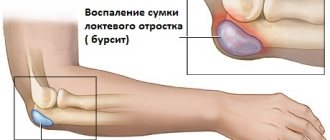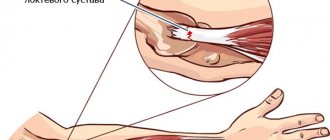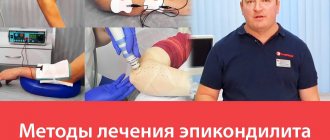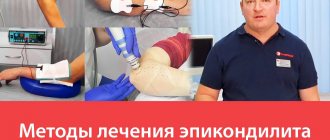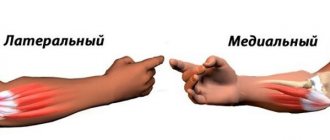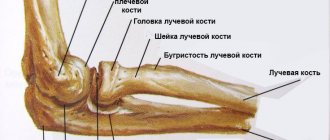When the tissues in the elbow joint are affected and the process is inflammatory and degenerative in nature, it is called epicondylitis or tennis elbow. The disease develops in the place where the forearm tendon attaches to the epicondyles of the shoulder bone. The main cause of epicondylitis is the presence of chronic overload of the forearm muscles.
This disease is characterized by a pathological process in the periosteum bone and tendons. The external and internal condyles are affected. As a result, styloiditis develops, and pain occurs in the place where the tendons of the muscles that abduct and extend the thumb are attached.
Considering the location, epicondylitis can be external or internal. External occurs several times more often and mainly affects men. If a person is right-handed, the right hand will be affected; if a person is left-handed, the left hand will be affected. If we talk about the age range, the disease appears between 35 and 55 years. The likelihood of developing the disease increases in those people whose activities involve constant repetition of the same monotonous movement (driver, athlete, pianist, tennis player, etc.).
Lateral epicondylitis of the elbow joint (tennis elbow)
Lateral epicondylitis of the elbow, commonly known as tennis elbow.
But this disease often occurs in people who have nothing to do with tennis. When playing tennis, the racket is struck mainly by extension movements of the forearm and hand. This strains the wrist extensor muscles and tendons that attach to the lateral epicondyle of the humerus, resulting in epicondylitis.
But many other activities can also lead to lateral epicondylitis (tennis elbow).
This guide will help you understand:
- What structures of the elbow are involved in the process?
- Causes of epicondylitis
- Treatment options
How to recognize epicondylitis
General symptoms are as follows:
- The appearance of spontaneous intense and burning pain in the elbow joint. Such pain later turns into dull and aching.
- Pain increases during physical activity on the elbow or when the muscles of the forearm are tense.
- Muscle strength is lost in the affected limb. This happens gradually.
Lateral epicondylitis is characterized by the spread of pain to the outer surface of the elbow joint. The pain will intensify if you straighten your wrist or rotate your hand. There is a certain test - a coffee cup. If a person tries to take a cup containing liquid from the table surface, he will notice that the pain begins to intensify. In addition, an increase in the intensity of pain will occur if the forearm is turned outward.
The localization of pain during medial epicondylitis is the inner surface of the elbow joint. Increased pain occurs if you flex the forearm or resist passive flexion of the wrist. Soreness can be transmitted through the internal muscles of the forearm to the hand. The motor range of motion of the joint will be sharply limited.
There is an acute, subacute and chronic stage of the disease. At first, the pain is accompanied by sudden or short-term muscle tension, then it becomes constant. The muscles of the affected limb will quickly become tired. The acute stage is characterized by a decrease in the intensity of the pain syndrome, and if you keep your hand at rest, the pain will disappear. During the chronic stage, remissions and relapses alternate. The time period varies from three to six months.
Causes of epicondylitis (tennis elbow)
- Excessive stress on the muscles and tendons of the forearm is the most common cause of lateral epicondylitis of the elbow. Constantly repeating certain movements of the hand can lead to inflammation of the tendon part of the extensor muscles of the hand. These movements do not necessarily have to be associated with high sports loads.
- However, tennis elbow is often not associated with inflammation. Sometimes, the problem lies in the tendon tissue itself. This condition is called tendinitis. Wear and tear is believed to lead to tissue degeneration. Degenerative tendons usually have an abnormal arrangement of collagen fibers.
Why does the disease appear?
The development of the disease is characterized by degenerative changes in the joint, which are the cause of the inflammatory process. Provoking factors include:
1. what is a person’s main job?
2. the presence of regular microtraumas or direct injuries to the elbow joint.
3. chronic overload of joints.
4. impaired local blood circulation.
5. cervical or thoracic osteochondrosis, osteoporosis, glenohumeral periarthritis.
In most cases, the diagnosis of epicondylitis is made to a person who repeats a certain movement with his hands: pronation (forearm turns inward, palm down), supination (outward turn, palm up). The risk group includes:
- agricultural workers (tractor drivers, milkmaids).
- Builders (masons, plasterers, painters).
- Athletes (boxers, weightlifters).
- Doctors (surgeons, massage therapists).
- Musicians (pianists, violinists).
- Service workers (hairdressers, ironers, typists).
In fact, the above professions are not the cause of epicondylitis. The disease appears when the muscles of the forearm are overloaded, resulting in the appearance of systematic microtraumas of the periarticular tissue. Therefore, the inflammatory process develops, small scars appear, as a result of which the tendon’s resistance to stress decreases. In addition, high muscle tension causes an increase in the number of microtraumas.
There are situations when the occurrence of epicondylitis is associated with direct injury, congenital weak ligaments, or a single intense muscle strain. In addition, epicondylitis is associated with osteochondrosis, osteoporosis, periarthritis, dysplasia, and poor circulation.
Diagnosis of tennis elbow
Diagnosis of tennis elbow begins with a detailed interview with the patient. The doctor must find out how long ago these symptoms began, whether they were preceded by injury, and with what movements the pain occurs.
Then the elbow joint area is examined. The doctor performs functional tests to confirm the diagnosis.
Functional diagnostic methods may be needed: X-rays of the elbow joint to exclude other diseases. An x-ray can determine whether there is calcification (calcium deposits) in the area of the epicondyle.
Ultrasound examination (ultrasound) allows you to obtain an image of the structures of interest and determine their size and localization.
Magnetic resonance imaging (MRI) clearly shows soft tissue: altered tendons, inflamed areas.
Reasons for development.
Most often caused by repetitive movements that involve the wrist muscles. Activities that create excessive mechanical stress create microtears and initiate degenerative development of the extensor tendon. Patients with chronic pain show signs of tissue necrosis and the presence of regeneration. In the progressive stages of tendinopathy, there is cell death and disorganization in the cellular matrix. The first type of collagen is replaced by a third, which leads to weakening of the tendon and reduces its resistance to stretching.
Normal type 1 collagen structure in healthy tendon
Degenerative tendinopathy - changes in the collagen matrix, tissue necrosis and replacement of type 1 collagen with less elastic type 3
The condition worsens with intense and prolonged work of the muscles - they spasm, local inflammation of the “squeezed” nerve appears, followed by disruption of its function and deterioration of nutrition of muscle and other structures, weakening of the blood supply. As a result, degenerative-dystrophic processes occur and the likelihood of injury increases. When injured, the damaged area is replaced by scar tissue, which further weakens the tendon and disrupts its trophism. New injuries occur and degenerative processes worsen.
The following are factors that contribute to the occurrence of the disease:
- 1. Types of tennis, badminton. Often the pathology is provoked by incorrect striking technique, so it is extremely important to monitor its execution (especially when the first symptoms appear).
- 2. Other sports when there is tension in the muscles of the shoulder and forearm (boxing, weights, wrestling).
- 3. Work of a painter, mason, programmer, seamstress, milkmaid, etc.
- 4. Changes caused by old age.
- 5. Concomitant vascular and endocrine diseases.
Conservative treatment of lateral epicondylitis of the elbow joint
The goal of conservative treatment for lateral epicondylitis is to help the tendon heal.
- NSAIDs (Non-steroidal anti-inflammatory drugs):
NSAIDs are prescribed to reduce pain and inflammation so that the patient can go about their daily activities. Due to the anti-inflammatory effect, blood cells stop performing their aggressive actions (destroying tendon tissue). Which breaks the chain of the running inflammatory reaction. This reduces swelling and pain.
- Immobilization: Elbow brace or taping
This helps limit movement in the elbow joint, allowing the inflamed structures to heal without additional trauma to the tendon portion of the extensor muscles of the hand and fingers.
- Shock wave therapy
In extracorporeal shock wave therapy, a device is used that produces shock waves that penetrate the skin into the area of inflammation (painful area) of the epicondyle. Due to this, inflamed tissues heal and are restored faster. The number of procedures required for cure is individual for each patient. As a rule, 4-6 procedures are performed. Frequency of execution: 1 time per week. This time is needed for the body to begin to cope with inflammation on its own, after shock therapy has “pushed” it by improving the blood supply to the inflamed area.
The main contraindication for shock wave therapy for lateral epicondylitis of the elbow joint:
-Oncological diseases
If this therapy is ineffective, steroid drugs are prescribed.
- Hormonal anti-inflammatory drugs.
Hormonal drugs are very effective in reducing inflammation in the lesion, but you should not start treatment with them. After all, this is the introduction of a hormone into the body. In the case of repeated frequent injections, the strength of the tendons (collagen fibers) decreases, even to the point of rupture under normal loads.
Types of disease
Considering the localization of epicondylitis, it can be external, external (the tendons that attach to the external epicondyle are damaged), internal (the tendon that comes from the internal epicondyle becomes inflamed).
With external or lateral epicondylitis, the inflammatory process is observed in the place where the muscle tendons attach to the external epicondyle of the bone. The appearance of this problem is typical for those whose extensor muscles are constantly overstrained. This type of disease can be determined using certain tests. It is called the handshake symptom. When shaking hands, the person will feel pain. In addition, painful sensations will occur if you turn your hand so that your palm is up, or straighten your forearm.
In medial or internal epicondylitis, the area where the muscle tendons attach to the internal epicondyle of the bone is affected. A distinctive feature of this type of epicondylitis from external one is the lighter loads that caused the disease. Performing monotonous stereotypical movements occurs with the help of the carpal flexor muscles.
In most cases, painful sensations appear if you press on the inner epicondyle or bend the forearm. Internal epicondylitis is characterized by a chronic form. In addition, the ulnar nerve is affected.
With traumatic epicondylitis, which occurs due to systematic minor trauma when performing the same type of action, deformation of the elbow joint occurs, and the ulnar nerve is also affected and the development of cervical osteochondrosis is observed. In a person over 45 years old, there is a decrease in the ability of tissue regeneration, so the damaged structure will be slowly replaced by connective tissues.
Another type of epicondylitis is post-traumatic. Its development occurs as a result of a sprain or dislocation of a joint, as well as if a person does not follow medical recommendations well during the rehabilitation period and is in a hurry to move on to intense loads on the joint.
In the chronic form, which is characteristic of this disease, for a long time (alternating exacerbations and relapses) the painful sensations will become weak and aching. In addition, muscle strength will be lost, as a result of which a person will no longer be able to take even light objects in his hand.
Surgical treatment of lateral epicondylitis of the elbow joint
Sometimes conservative treatment is not able to eliminate pain or help the patient regain full range of motion with lateral epicondylitis of the elbow (tennis elbow). In such cases, surgery is recommended.
This operation relieves tension in the tendon portion of the wrist extensor muscles. During the operation, an incision is made in the area of the lateral epicondyle, and the surgeon carefully reaches the site of attachment of the extensor muscles.
Then the tendon is cut off at the point of attachment. Inflamed, scar tissue and calcifications are removed. The severed tendons are sutured to the fascia of nearby muscles. The skin is then sutured.
Surgery for lateral epicondylitis is performed on an outpatient basis under local or regional anesthesia, which means that the patient does not have to stay in the hospital.
An alternative minimally invasive treatment is the laser ablation method.
Which is carried out through a small incision of 5-10mm in the skin. The essence of tennis elbow surgery is that the attachment site is treated with a laser or radio wave ablation device. This causes simultaneous removal of the inflamed areas of the tendon and coagulates the vessels.
How to identify epicondylitis
To diagnose such a disease, a person must first be interviewed, study medical history and visual inspection. If we talk about another destructive lesion of the elbow joint, then a distinctive feature of epicondylitis is the specificity of painful sensations. This disease is characterized by the appearance of pain when a person independently loads the joint. When the doctor makes various movements of the patient's injured limb (this is called passive flexion and extension), no painful sensations will appear. This is the difference between epicondylitis and diseases such as arthritis and arthrosis.
Another diagnostic measure is testing. For example, during the Thompson test, the victim squeezes his hand. She will quickly turn around and move to the position where her palm is up. To identify the welta symptom, it is necessary to fix the forearm so that it is at the same level as the chin, and simultaneously extend and flex the arm. These actions performed by the affected hand will lag behind those performed by the healthy hand. When performing these tests, a person experiences severe pain.
Disease in persons with deforming osteoarthritis
It is believed that the tennis player's disease develops due to frequent flexion/extension of the arm at the elbow joint. However, long-term deforming osteoarthritis often leads to degenerative-dystrophic changes in tendons. According to statistics, characteristic signs of epicondylitis are detected in 75-80% of patients with arthrosis of the elbow joint.
Ultrasound examination in such patients shows unclear visualization of the tendons. Upon closer examination, they reveal an- and hypoechoic areas. Extratendinous calcifications are detected in the soft tissues, and mild signs of degenerative changes are observed in the cortical bone layer. In some patients, osteophytes are also visualized.
Osteophyte (spike) on x-ray.
Features of epicondylitis in osteoarthritis:
- It is characterized by the involvement of both epicondyles in the pathological process at once.
- It is much more common in females.
- Has a tendency to last a long time without spontaneous self-healing.
Bilateral epicondylitis is rare in clinical practice. As a rule, it is detected in individuals with deforming osteoarthritis. The pathology is characterized by pain in the elbow when flexing and extending the hand.
Prices
| Disease | Approximate price, $ |
| Prices for hip replacement | 23 100 |
| Prices for clubfoot treatment | 25 300 |
| Prices for Hallux Valgus treatment | 7 980 |
| Prices for knee joint restoration | 13 580 — 27 710 |
| Prices for scoliosis treatment | 9 190 — 66 910 |
| Prices for knee replacement | 28 200 |
| Prices for treatment of intervertebral hernia | 35 320 — 47 370 |
Symptoms and course of the disease
Symptoms of external epicondylitis include the following manifestations: pain in the forearm when palpating, during extension, during supination; Usually these pains can spread along the outer line of the entire arm. The pain of epicondylitis is characterized by rapid progression and appears with even very mild muscle tension.
In acute epicondylitis, the pain is constant and quite intense. In subacute epicondylitis, pain is less intense and occurs during physical activity of the forearm and arm.
With prolonged hand position at rest, the pain subsides and even disappears. Visually, the elbow joint does not change, and its passive movements are not limited in any way.
The internal form of epicondylitis manifests itself in almost the same way, but with a different location of the inflammatory process: pain manifests itself upon palpation of the inner side of the epicondyle and with rotational movements of the forearm. When pressing on the site of inflammation, pain can radiate along the entire inner line of the forearm.
Internal epicondylitis always has a chronic course and development.


